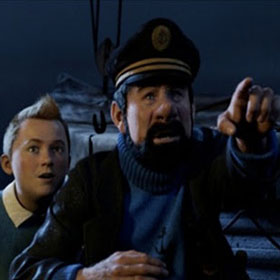The Adventures Of Tintin

3.5/5
There’s no question about it, Steven Spielberg is in love with Tintin. Otherwise, why would he chose the dangerously inquisitive protagonist of the Hergé comics as his first entry point into the world of digital animation – motion capture animation to be precise – as well as his first comic book adaptation. Spielberg has built his reputation over the years on making movies with the emphasis on movement. He is known for being a connoisseur of the physical medium, spending many a tedious hour in the editing room piecing together actual reels of film. In fact, Spielberg originally meant for his adaptation of Tintin to be live action shot by traditional methods, but Peter Jackson convinced him otherwise. Spielberg is also known for his masterful hand when it comes to orchestrating actions sequences, and if there’s anything to be said about The Adventures of Tintin, it’s that the action is akin to ballet, and the digital renderings, thanks to producer, Jackson, and his studio, Weta Digital, are just as breathtaking.
The Adventures of Tintin opens up with the eponymous character buying an antique model ship in a street market. Almost immediately, he is thrust into a game of intrigue involving a cursed line of sea captains and a legendary missing vessel, the Unicorn. Attempting to unravel the mystery, Tintin and his faithful canine, Snowy, are kidnapped and put aboard a cargo ship bound for Morocco. Tintin, of course, escapes and teams up with boozy Captain Haddock whose ship and crew has been commandeered by the sinister Mr. Sakharine. Once Tintin and Haddock arrive in Morocco, they find that the Sheikh has one of the three model Unicorns, and they uncover Sakharine’s plan for stealing it, thereby piecing together the clues that will lead to the final resting place of the sunken ship and her hidden treasures. But as we learn later on in the movie, treasure is not the only thing Sakharine is after.
The plot of Tintin seems on par with some of Spielberg’s better-known movies, providing an experience that leaves the viewer satisfied – no open holes and no questions. But to say that Tintin is epic may be a bit of an overstatement. It is certainly an entertaining movie, replete with a straightforward plot and dynamic enough characters. However, the movie does lack anything really unexpected. No plot twists or intriguing reveals, just good-old-fashioned storytelling, which in some sense provides for a relatively hollow production. But, on the other hand, the movie is devoid of pretention or posturing. If comic books, such as Tintin, travel along an open and direct plotline, rather than say, explore archetypes or answer philosophical questions, then a movie version of the comic should follow suit. And Spielberg’s insistence on doing this is perhaps a testament to his love and respect for the Tintin books.
But the story isn’t the real reason you’re going to see The Adventure of Tintin. Spielberg is king when it comes to creating action sequences that are as beautiful as they are impossible. When Tintin is sliding down a clothesline with the front half a motorcycle, no one says, “wait a minute,” we only hold our breath. And when Tintin is jumping from rooftop to rooftop, miraculously dodging machine gun fire, it looks completely natural, like something any normal person is capable of doing. At times, the action gets dizzying but in a good way; such is the original and creative methods with which it is executed. More so, The Adventures of Tintin doesn’t balk at what inherently accompanies action -violence. Although the movie is tagged as PG, there are still people getting shot and stabbed. People do die. Tintin himself, aside from being a world-class brawler, is often seen toting a handgun, and to an extent relies on it for safety. This is noteworthy because the film is able to appeal to viewers of any age. It’s not that a gunfight or violence is necessary in order to be appreciated by anyone over the age of twelve; it’s just that Spielberg and Jackson have put together an animated action movie that includes, ta-da, actual exciting action. The result is a relatively mature movie, especially from a studio (Nickelodeon) that is geared towards a younger audience.
Sure, Tintin is no Raiders of the Lost Arc or Lord of the Rings, but it is still a solid and meticulously crafted film that deserves at least some commendation. And sure, Tintin perhaps relies too heavily on action, but we’re ok with that, because it’s done with such professionalism and with such high quality production values that we’re able to appreciate the movie as a whole. The storyline doesn’t suck, but it’s not that textured either. And when you think about it, how many action movies can you say pull that off? The Adventures of Tintin is not a classic by far, but it’s still a hell of a lot of fun.
RELATED ARTICLES
Get the most-revealing celebrity conversations with the uInterview podcast!





Leave a comment